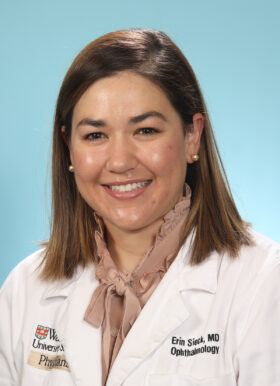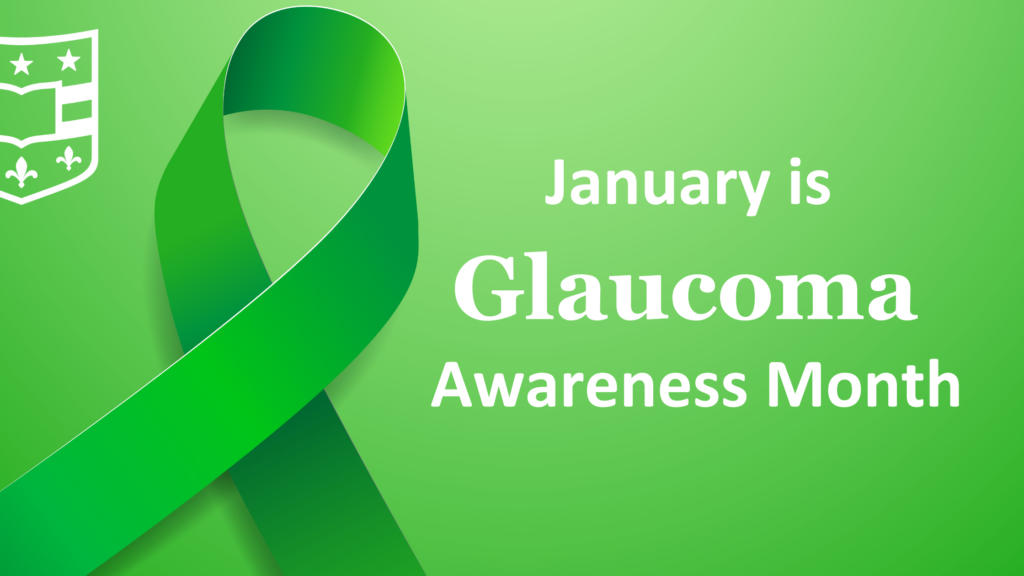Glaucoma Awareness Month shines a light on this “silent thief of sight,” a condition that often progresses without symptoms but can lead to irreversible vision loss. Below, we address the top five questions patients frequently ask about glaucoma, with insights from leading researchers and clinicians at WashU Medicine.
1. What is glaucoma, and how does it affect vision?
Glaucoma is a group of eye diseases that damage the optic nerve, often due to increased pressure in the eye. This nerve is essential for transmitting visual information from the eye to the brain, and damage to it can result in vision loss or blindness.
“Most people’s vision is still good with glaucoma. It typically causes changes to your peripheral vision before your central vision is affected, but that is not always the case. Once glaucoma develops, it cannot be reversed.”
Erin G. Sieck, MD

Erin Sieck, MD
Assistant Professor, Ophthalmology and Visual Sciences; Fellowship Director Advanced Anterior Segment and Glaucoma Surgery; Director of Ophthalmology Continuing Medical Education
- Email: erin.sieck@nospam.wustl.edu
2. Who is at risk for developing glaucoma?
Several factors increase the risk of glaucoma, including:
- Age: People over 60 are at higher risk.
- Family History: A family history of glaucoma significantly increases your chances.
- Ethnicity: African Americans and Hispanics are more prone to the condition.
- Medical Conditions: Diabetes, hypertension, and certain eye conditions also elevate risk.
Since early glaucoma is usually without symptoms of vision loss, awareness of these important risk factors for glaucoma guides who should undergo a comprehensive eye exam to determine if one has findings of glaucoma. Individuals with first-degree relatives (mother/father/sister/brother/son/daughter) with glaucoma are at up to 10x risk of developing glaucoma.
Carla Siegfried, MD

Carla Siegfried, MD
Jacquelyn E. and Allan E. Kolker, MD, Distinguished Professor of Ophthalmology and Visual Sciences; Vice Chair for Diversity, Equity and Professionalism
- Email: siegfried@nospam.wustl.edu
3. What are the early warning signs of glaucoma?
Glaucoma is often called the “silent thief of sight” because most people don’t notice symptoms until significant damage has occurred. However, there are some warning signs for specific types of glaucoma, such as:
- Open-Angle Glaucoma: Gradual loss of peripheral vision.
- Angle-Closure Glaucoma: Sudden eye pain, nausea, blurred vision, and halos around lights.
“You might not know you have glaucoma. So if you have any of the risk factors listed above or any of the signs or symptoms, please seek an eye specialist for an exam. During our exam we will perform testing and check your eye pressure to determine if you have glaucoma.”
Erin G. Sieck, MD
4. How is glaucoma treated?
Treatment focuses on lowering intraocular pressure (IOP) to prevent further optic nerve damage. Common options include:
- Medications: Eye drops or oral medications.
- Surgery: Minimally invasive glaucoma surgeries (MIGS) including goniotomy, viscodilation, endoscopic cyclophotocoagulation, trabecular stents and subconjunuctival gel stents. Procedures like trabeculectomy and tube shunt surgeries may also be performed.
- Laser Therapy: Procedures like SLT (Selective Laser Trabeculoplasty) , LPI ( Laser Peripheral Iridotomy) and CPC (Diode Cyclophotocoagulation).
“There is no single best treatment for each eye with glaucoma, much less for each patient. As glaucoma surgeons, we balance the risks and benefits of each procedure and tailor them to the eye undergoing treatment. With advances in laser and device technology, we may be able to delay the need for more invasive surgical procedures as glaucoma requires lifelong care.”
Arsham Sheybani, MD
5. Can glaucoma be prevented?
While glaucoma damage cannot be reversed, early detection and management are key to preserving vision and preventing further decline. Regular eye exams, especially for high-risk individuals, are the best defense.
“Once glaucoma damage occurs, it cannot be reversed. To prevent further vision loss, regular monitoring by your eye care specialist and adherence to the recommended treatment plan are crucial. Routine glaucoma testing in the clinic helps detect changes in the disease, which can otherwise go unnoticed in day-to-day activities.”
James Liu, MD

James Liu, MD
Assistant Professor, Ophthalmology and Visual Sciences; Director of Surgical Training and Skills Lab
Expert Insights from WashU Medicine Glaucoma Specialists
Throughout January, we’ll be sharing more insights from WashU researchers on groundbreaking studies and treatment advancements. Dr. Sheybani’s advancements in minimally invasive glaucoma surgeries (MIGS), Dr. Siegfried’s exploration of oxidative stress and intraocular pressure fluctuations, Dr. Liu’s focus on optimizing glaucoma screening and surgical practices, and Dr. Sieck’s research on uveitic glaucoma highlight how WashU Medicine is at the forefront of shaping the future of glaucoma care.
Together, we can spread awareness and protect vision for generations to come.
Glaucoma Research at WashU Medicine
Dr. Carla Siegfried’s Research:
Dr. Siegfried’s work focuses on the role of oxidative stress in the development of glaucoma. Her studies have included measurements of antioxidant capacities in the eye and how the eye processes oxygen. Notably, she has explored how surgical procedures, such as lens removal and vitrectomy, alter intraocular oxygen levels, potentially increasing oxidative stress and the risk of glaucoma. She is currently studying racial disparities in glaucoma based on differences in function and genetic expression of trabecular meshwork cells, which are involved in controlling intraocular pressure, the most important and only modifiable risk factor for glaucoma. She and her clinical colleagues collect specimens of these cells during glaucoma surgery for further analysis.
Recent publications:
- Manuscript on oxidative stress in glaucoma patients
- Study on the impact of vitrectomy on intraocular oxygen levels
In recognition of her innovative research, Dr. Siegfried received the 2018 Shaffer Prize for her project exploring the role of oxygen and antioxidant levels in the eye.
For a more in-depth understanding of Dr. Siegfried’s innovative glaucoma research, you might find the following video informative: Dr. Siegfried’s Research Video
Dr. Arsham Sheybani’s Research:
Dr. Sheybani specializes in advanced surgical treatments for glaucoma, including minimally invasive glaucoma surgeries (MIGS). His research encompasses the efficacy and safety of various surgical interventions. For instance, he has conducted studies comparing the outcomes of gel stent implantation versus traditional trabeculectomy in patients with open-angle glaucoma.
Recent publications:
Dr. James C. Liu’s Research:
Dr. Liu’s research focuses on glaucoma screening and optimizing surgical practice patterns. As an Assistant Professor in the Division of Glaucoma, he is dedicated to enhancing early detection methods and refining surgical techniques to improve patient outcomes. His clinical expertise includes medical treatment, traditional surgery, laser therapies, and minimally invasive glaucoma surgeries (MIGS).
For more detailed information about Dr. Liu, you can visit his profile on the WashU Physicians website: Dr. James C. Liu
Dr. Erin G. Sieck’s Research:
Dr. Sieck specializes in uveitic glaucoma and glaucoma surgical outcomes. Her research aims to develop individualized care strategies for patients with uveitic glaucoma, a complex condition resulting from inflammation within the eye. By collaborating closely with uveitis specialists, she seeks to improve treatment protocols and surgical outcomes for this patient population.
For more detailed information about Dr. Sieck, you can visit her profile on the WashU Physicians website: Dr. Erin G. Sieck
